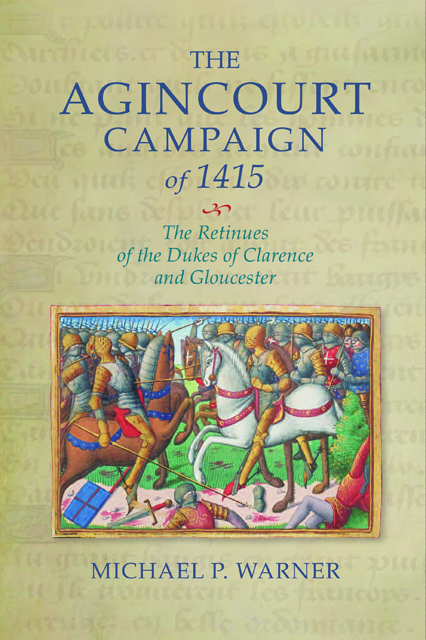Book contents
- Frontmatter
- Contents
- Lists of Tables and Charts
- List of Figures
- Acknowledgements
- Abbreviations
- Introduction
- 1 Before the Campaign
- 2 The Muster Rolls of the 1415 Expedition
- 3 Clarence’s and Gloucester’s 1415 Retinues
- 4 The Sub-Retinue Captains
- 5 During the Campaign
- 6 After the Campaign
- Conclusion
- Appendices
- Bibliography
- Index
- Warfare in History
4 - The Sub-Retinue Captains
Published online by Cambridge University Press: 14 January 2023
- Frontmatter
- Contents
- Lists of Tables and Charts
- List of Figures
- Acknowledgements
- Abbreviations
- Introduction
- 1 Before the Campaign
- 2 The Muster Rolls of the 1415 Expedition
- 3 Clarence’s and Gloucester’s 1415 Retinues
- 4 The Sub-Retinue Captains
- 5 During the Campaign
- 6 After the Campaign
- Conclusion
- Appendices
- Bibliography
- Index
- Warfare in History
Summary
Military Service Ties
The sub-retinue captains form an illustrative group that provide valuable insights into the mechanics and dynamics underlying the recruitment, stability and professionalism of a retinue. One way to assess the vertical and horizontal stability engendered by the dukes’ sub-captains is to quantify their military service history. It must be stressed again that we have a notable lack of nominal military service sources from the decade or so before 1415, particularly for the forces led by Clarence, for instance in 1412. As such, the figures presented here must be taken as a bare minimum, indicative of the situation, not the complete picture. Beginning with Clarence’s retinue, prior to serving under him in 1415, 25 (41%) of his 61 sub-captains had undertaken military service. Digging deeper, 15 (26%) had performed military service under the direct command of the duke before, with the majority having marched through France with him in 1412. On this occasion, 10 (16%) of the sub-captains served him. Considering that less than 5% of Clarence’s 1412 retinue is identifiable, this is a high figure, indicative of vertical stability. It must be noted, however, that apart from Henry Mulso, none of Clarence’s 1415 sub-captains can be shown to have been under his direct military command more than once before the 1415 campaign. Indeed, even though Mulso is noted as having served Clarence twice, this was in name only. There is no evidence that Clarence was present at Guînes Castle in 1413, the time when Mulso was there under his nominal captaincy.
The apparent lack of direct re-service under Clarence may lead to suggestions that his retinue is evidence that the trend of declining retinue stability in the late fourteenth century continued into the fifteenth. This would certainly seem to be the case when considered alongside Bell’s study of Arundel’s fleets of 1387 and 1388. As explained earlier, Bell’s study was undertaken before the publication of the Medieval Soldier Database. Consequently, the military service statistics he provided for Arundel’s captain on those campaigns are now in need of updating. Using the Medieval Soldier Database, I have updated this and present the findings here.
The force that sailed under the command of Arundel in 1387 comprised 2,497 men, 1,107 men-at-arms and 1,390 archers. These men were recruited in 29 retinues, including Arundel’s personal company, which was the largest.
- Type
- Chapter
- Information
- The Agincourt Campaign of 1415The Retinues of the Dukes of Clarence and Gloucester, pp. 89 - 132Publisher: Boydell & BrewerPrint publication year: 2021

